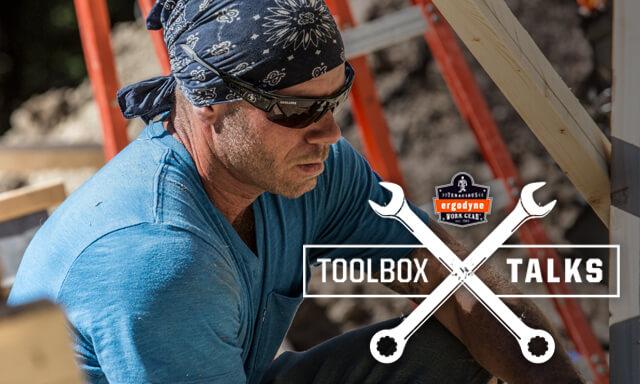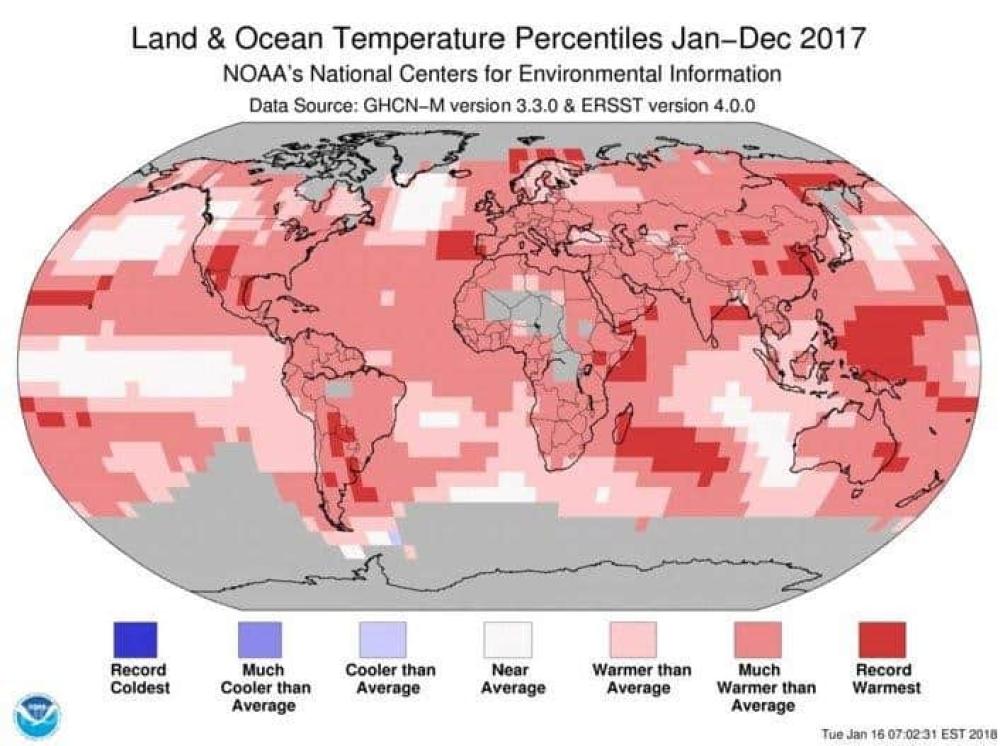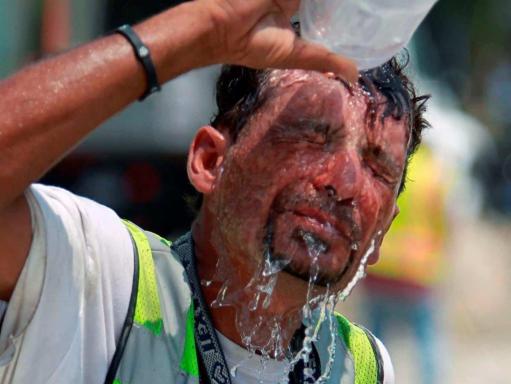Warning Signs and Symptoms of Heat-Related Illness – Toolbox Talks

If it seems like summers have been getting hotter and more extreme, you’re right—on average, summers over the past decade have been hotter on average and bring more heat waves with temperatures that fall into the “extremely hot” category.
Summers that would have been considered extraordinarily hot back in the 1950s are commonplace today. Since 2005, average summer temperatures have shifted drastically. Over the following 10 years, two-thirds of the temperatures recorded fell into the “hot” category and the other one-third of temperatures measured fell into the “extremely hot” category.

This presents a challenge for you as you look to keep your workers safe in extreme weather. Heat stress can, and does, result in death. Heat is the number one weather-related killer in the United States, and kills an average of 650 people each year, according to the Bureau of Labor Statistics.
Additionally, a stressed body can’t work at optimal speed or performance, and fine motor skills are often impaired. Not to mention, according to USA Today, 65% of workers either don’t want to work or work at a much slower pace in heat and humidity.
HOW THE BODY COOLS ITSELF
-
The body regulates temperature like a furnace – constantly producing and dispersing heat through various processes
-
To dissipate heat, arteries and veins near the skin fill up to let heat energy radiate out of the body
-
Body begins to sweat which cools the skin by evaporation
-
When the air temperature is close or above normal body temperature, cooling of the body becomes more difficult
-
If the body cannot get rid of excess heat, it will store it and the core temperature rises
When the body begins to heat up, the brain sends signals to the skin to increase sweat production, which helps cool the body as the sweat evaporates on the skin. In temperate or dry climates, this is an effective way to keep the body cool, but in humid environments, the sweat can’t evaporate as easily which makes it a less effective way for the body to cool itself, and heat stress poses more of a threat.
Heat stress is when the body’s ability to control its internal temperature begins to fail. Body temps rise above 99.7° F (37.6° C) and the body begins to sweat profusely. If the body isn’t allowed to cool down, severe heat-related illness can happen when the body temp reaches 104° F (40° C).
Symptoms of heat stress include profuse sweating, heat cramps, red skin, rapid pulse and weakness. If left untreated, the person will eventually stop sweating and have hot, dry skin. Once the body temperature reaches 104° F (40° C) or above, medical attention is needed immediately. Look for pale skin, nausea, vomiting, and confusion.
There are four common heat-related illnesses and one illness can quickly progress to the next, while increasing in severity if left untreated.
COMMON HEAT-RELATED ILLNESSES
Heat Rash:
Caused by clogged sweat ducts under the skin, restricting the body’s ability to release heat.
What to look for: Small red, blister-like eruptions or itchy bumps.
Treatment: Dry skin off, rest in a shaded area, and rehydrate.
Heat Cramps:
Caused by rapid sweat loss and dehydration which can lead to painful spasms, usually in the legs or abdomen. This is usually the first sign of a heat-related illness.
What to look for: Cramps or involuntary spasms in the major muscles that are being stressed. Heat cramps can occur even after the work is completed/the shift is over.
Treatment: Rest in a cool or shaded area, do some light, static stretching of the affected muscles (no bouncing or straining), and drink a sports drink which has beneficial salt and electrolytes that are lost in sweat.
Heat Exhaustion:
Heat Exhaustion happens when your body can’t properly cool itself when exposed to high temperatures or high humidity. Signs and symptoms may develop suddenly or over time. Primary symptoms include heavy sweating and a rapid pulse as the body overheats.
What to look for:
-
Profuse sweating
-
Weakness
-
Nausea
-
Vomiting
-
Headache
-
Lightheadedness
-
Rapid pulse
-
Muscle cramps
Treatment: Move to a shaded area and re-hydrate. Remove excess clothing and equipment in order to allow sweat to evaporate from the skin. Place cool, wet towels on the skin if possible.
Heat Stroke:
Heat stroke is the most serious heat-related illness and should be treated immediately by a medical professional. If left untreated, heat stroke can be fatal. People suffering from heat stroke can collapse and if you suspect someone is suffering from heat stroke, get medical attention immediately.
What to look for:
-
Lack of sweating, despite the heat
-
Red, hot, dry skin
-
Dizziness and light-headedness
-
Nausea
-
Vomiting
-
Throbbing headache
-
Confusion, disorientation, staggering
-
Muscle weakness or cramps
-
Rapid, shallow breathing
-
Fever of 104° F or above
-
Seizures
-
Unconsciousness
Treatment: Heat stroke should be considered a medical emergency. Body temperature must be lowered below 102 degrees within 30 minutes of collapse to prevent irreversible damage to the body. Fluid replacement via IV may be necessary and the worker should get to a healthcare facility immediately. Douse in cold water or place wet towels over the entire body while waiting for medical attention. NOTE: Medical professionals should always supervise submergence into a tub of water.
HEAT-RELATED ILLNESS PREVENTION
-
Acclimatize to hot work environments
-
Wear loose-fitting, lightweight clothing when possible
-
Protect against sunburn, as sunburn affects your body’s ability to cool itself
-
Drink plenty of fluids, avoiding caffeine and alcohol which can be dehydrating
-
Avoid working during the hottest parts of the day

There are two sets of factors that come into play when considering the causes of heat stress on the body: personal and environmental. Being aware of these factors and knowing an individual’s risk factors will allow that person to be better prepared when the heat hits. While workers can’t do anything about some personal risk factors (like age, for example. The very young and the very old are much more susceptible to high temps), they can reduce risk by being mindful of their own fitness levels — watching their weight, staying hydrated, avoiding alcohol and drugs, getting plenty of sleep, etc.
Additionally, acclimatization — gradually increasing exposure to the heat — plays a large part in reducing stress on the body. By taking frequent cooling breaks and avoiding the temptation to push themselves in the heat, workers can build up tolerance to sweltering temps.
PERSONAL RISK FACTORS
-
Age, weight and personal fitness
-
Dehydration and loss of electrolytes
-
Illness/fever
-
Medical conditions
-
Certain medications
-
Diet/alcohol
-
Acclimatization
ENVIRONMENTAL FACTORS
-
High temperatures
-
Direct sunlight
-
Humidity
-
Limited air movement
-
Hot equipment
-
Heat reflected from ground, water, or objects
-
Physical exertion
-
Clothing/PPE
A number of environmental factors contribute to heat stress, including working on hot equipment, heat reflected from the ground, water or objects; limited air movement, direct sunlight, and high temperatures and humidity. All of these heat sources sap energy from the body as the heat load is increased. Taking frequent breaks in the shade and staying hydrated can help mitigate some of these environmental stressors.
TALK TO YOUR CREW
The work won’t stop when the mercury climbs, but heat-related illnesses are 100% preventable. Take a few minutes to educate your crew on the signs, symptoms and how to prevent and treat these common heat-related illnesses.


